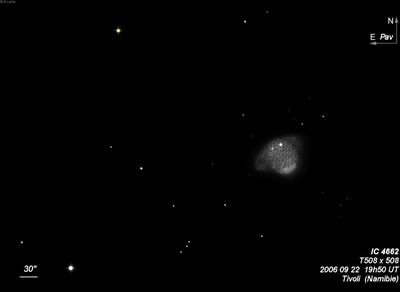
According to the article "Star formation in the irregular galaxy IC 4662" (A&A, 1990, 234, 99) the elongated knot on the northeast side contains two giant HII regions comparable to the 30 Doradus complex! IC 4662 is identical to He 2-269 (PK 328-17.1), which Karl Henize included in a 1967 list of planetary nebulae discovered through H-alpha emission on objective prism plates. In a 1970 paper, Pastoriza gave the classification as a nearby dwarf emission line galaxy with a radial velocity of ~400 km/sec (less than 10 million l.y.).
Robert Innes discovered IC 4662 visually in 1901 with the 7-inch Merz refractor at the Cape of Good Hope. He noted "a faint oval nebula 1' in diameter, N.p. Eta Pavonis. Found with the 7-inch." Based on plates taken at Arequipa, DeLisle Stewart noted "F, S, irr, 2 st. inv." Stewart referenced Innes' discovery announcement in MN 62, 470.
400/500mm - 18" (7/8/02 - Magellan Observatory, Australia): at 171x, this irregular galaxy has a disrupted appearance or perhaps is interacting with a companion. The structure is difficult to separate but the brighter component on the northeast side is moderately bright, small, elongated WNW-ESE. Attached on the south side is a larger, but fainter extension oriented nearly perpendicular to the brighter component. A faint star is at the edge. IC 4662 is located just 10' NE of mag 3.7 Eta Pavonis and the bright star interferes with viewing if left in the field.
Notes by Steve Gottlieb